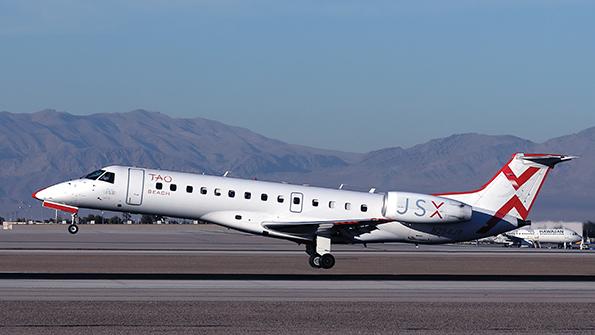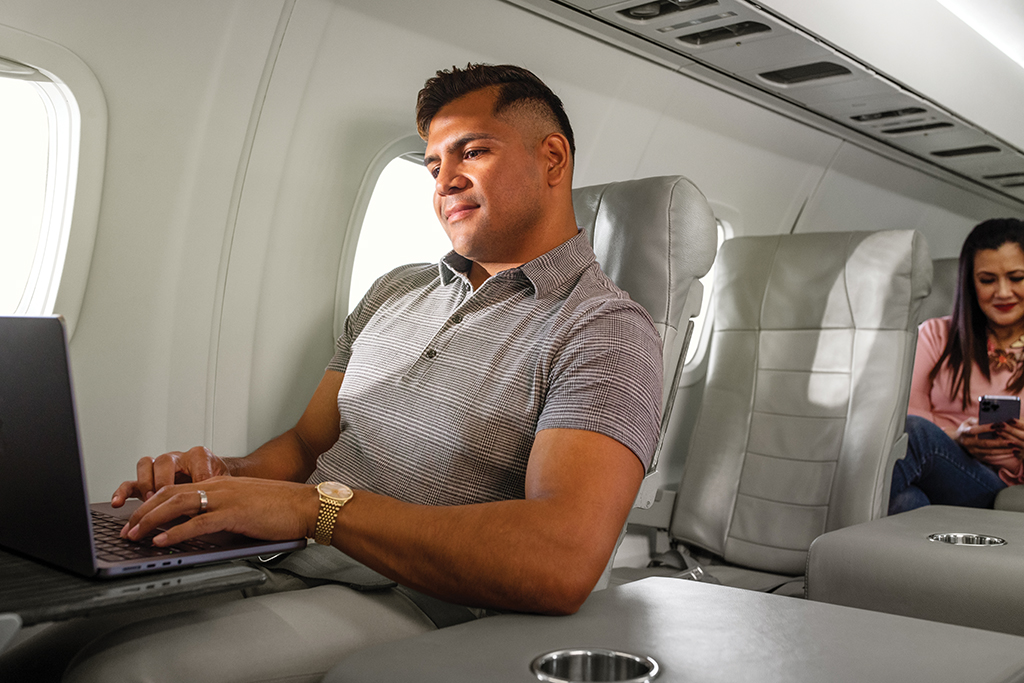
Alex Wilcox believes airline travel is broken. “They’re not efficient with respect to human time. They’re efficient in terms of getting people from point A to point B, but the missing ingredient is that when they get people to point B, they’re not necessarily joyful,” Wilcox, a co-founder and CEO at US commercial/charter hybrid carrier JSX, says. “We want people’s interaction with us to produce joy.”
Wilcox pointedly criticizes the average airport experience as a series of security checkpoints, crowds and a shopping mall, that requires passengers to show up two hours before a domestic flight.
“If the Wright brothers had seen what we’ve done to commercial aviation and all the barriers that we put between the individual who wants to get somewhere and getting on the airplane, they’d turn over in their graves,” he says.
In 2016, Wilcox and two co-founders launched JSX, creating a new category billed as a “hop on” jet service. This mashup of commercial, charter and executive aviation brings “private-ish” air travel to within affordable reach of the general public.

The Dallas-based company points out that JSX is not an airline but rather an air carrier, or more specifically, a public charter. Its FAA Part 135 status allows JSX to operate from fixed-based operators’ (FBO) private terminals but using Part 380 of US Department of Transportation (DOT) rules to sell tickets for scheduled flights. This translates into a frictionless ground experience and security screening, with passengers able to show up in as little as 20 minutes before their departure.
JSX views the limitations of Part 135 as opportunities, permitting JSX to do many things Part 121 scheduled airlines can’t do. The company is rapidly spooling up a nationwide expansion.
From two aircraft flying a sole Burbank to Concord, California, route in 2016, JSX’s initial California and Las Vegas bread-and-butter network has expanded to 43 routes across 22 North American markets, with a heavy emphasis on Texas from its Dallas Love Field Airport home base. Routes from Florida to New York and Mexico have been added. The point-to-point carrier’s traffic mix is skimming leisure demand in existing markets like Las Vegas to Los Angeles and Burbank, higher-frequency business markets like Dallas-Houston and Austin, Texas, as well as unserved routes with wealthy and large catchment areas using more convenient closer in executive airports like Boulder, Colorado, and Destin Executive in Florida.
The common denominator is catering to “high net worth individuals who appreciate and are willing to pay for the service that we deliver,” CCO John Redcay says.
These include people on a quick vacation seeking an elevated experience, second homeowners, private and fractional jet owners and, uniquely, pet owners, who constitute 10% of its revenue base.
The pet-friendly carrier developed a niche permitting cats and small dogs to be transported by customers in-cabin for free, as long as they are inside a secure carrier. Larger dogs up to 65 pounds are also welcome inside the cabin, as long as they are leashed and customers purchase a window seat in addition to an aisle seat to allow room for the dog. Free Instagram-friendly bandanas for pets are a popular perk. Additionally, the carrier is enjoying growth in corporate-managed travel, corporate shuttles, and additional charter work.
The company is embarking on a significant capacity growth phase. Redcay promises a doubling of seats in 2023 over 2022. JSX has identified 30 new markets primed for entry at any given time. Passenger numbers are already up 118% over 2019, with 750-plus weekly flights.
While Part 121 carriers are eligible to serve 517 airports, Part 135 status affords JSX 1,568 potential airports with at least 5,000-foot runways. Accessing appropriate real estate, such as FBO access, is one of their few constraints.
The future growth trajectory is “fish where the fish are,” Wilcox says. Prospective dots and lines on the map particularly favor the US east of the Mississippi River, where two-thirds of the population lives, but where JSX’s current presence is minimal. Operations in multiple airports in markets like South Florida, the San Francisco Bay area, and the New York Metropolitan area are also in the cards to maximize the differentiated product’s convenience.
There are no plans to create connecting hubs or even to sell connecting itineraries.
“We’re still in a high growth phase, and because we have limited resources, we’re not going to set ourselves up to fail because we need connecting customers,” Wilcox says.
The company’s network planners use a mix of data for private flying, historic passengers per day each way numbers, yields, general aviation traffic, US census data, customer behavior, and pure instinct to evaluate new markets.
Reconfigured ERJs
The differentiated private-like ground experience extends to the air with Embraer ERJ135s and 145s flying in low-density 30-seat configurations, which keep it under Part 121. The ERJ145 cabin is in a 1-1 configuration, with an in-house designed side table and 34-in. seat pitch more akin to an executive jet than a regional aircraft. The passenger experience includes the world’s first commercial aircraft to offer free ultra-high-speed Starlink internet via Space X, power at every seat, and a high level of catering.
As for the fleet, one airline’s discarded ERJ is JSX’s treasure. The carrier owns 77 ERJs outright with no debt. Thirty-seven were flying in March, with 1.5 new aircraft refurbished and inducted each month. Opportunistic purchasing of these regional jets and restoring them for 10% of new costs keep CapEx low.
“These airplanes are like a box of chocolates; you don’t know how good they are until you open them up,” Wilcox remarked.
While most will return to the skies, some high-time airframes due for C checks are parted out, providing low-cost parts for the rest of the fleet. The “acres and acres” of supply gives the ERJs “some 20 years of life, but we will need another platform at some point in the future,” Wilcox says.
Pilot supply
The company’s growth is not as constrained by the pilot shortages being experienced elsewhere in the US, most noticeably at regional airlines. JSX’s Part 135 status affords it a pilot base of one-third experienced retirees, one-third time-building pilots beginning with 600 hours of flight time (instead of the 1,500-hour minimum required for 121 flying), and one-third lifers drawn to the lifestyle benefits of 90% returning to base each night. JSX pilot recruitment draws from airline retiree organizations, flight schools, and United Airlines’ and JetBlue’s pilot pathway programs. United and JetBlue are both JSX shareholders, as is Qatar Airways, making this one of the most unusual sets of industry investors.
JSX is most proud of its diversity and inclusion efforts.
“We’re a minority majority,” JSX chief corporate soul officer Kevin Horan says, citing a crew membership in which 52% are people of color, including 33% of pilots. Women constitute 14% of the pilot base.
DOT doesn’t provide operating statistics for Part 135 carriers. The company claims it recorded a 99.3% completion factor and average loads of around 80%. JSX aspires to reach an A14 goal (arriving within 14 minutes of the scheduled time) of 90%, but executives admit there is still work to do from the current 80% levels. The carrier does get ahead of irregular operations with proactive refunds and rebooking. JSX’s overall customer-centric approach has garnered a stratospheric, by industry standards, 82 Net Promotor Score.
In early April, the company will move into new Love Field all-in-one network operations, line-maintenance hangar, terminal and corporate offices. JSX has also inked a heavy maintenance agreement with MRO Embraer Aircraft Maintenance Services in Georgia.
JSX eschews common industry unit cost and RASM metrics, preferring to measure hourly revenue.
“We look seemingly expensive on a CASM basis because there are only 30 seats. The great news is we would also look obscenely rich in terms of the fare that we get,” Wilcox laughs.
The privately held company is projected to post over $500 million in revenue this year and achieve positive cash flow within a year. JSX has major investors with deep pockets of cash and credibility, including two private family investment offices in addition to United, Qatar Airways and JetBlue.
With a strong balance sheet, fully depreciated aircraft, and no need to tap the capital markets to power its growth, Wilcox says none of the investors are “heading for the doors.” However, he doesn’t rule out a public offering sometime in the future. The three-airline unlikely ownership bedfellows offer additional benefits, including loyalty program earn and burns, recruiting, and codesharing.
This nichiest of niche carriers is blazing its own unusual trail in the US air transport market, but Wilcox is looking to the future: “We’re 80% there, but that last 3% is going to continue to separate us from everybody else.

